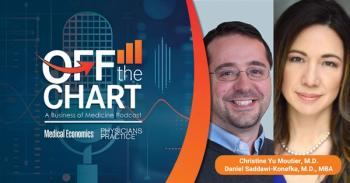
Physicians Find Relief from Burnout in DPC
Feeling burnout symptoms, physicians nationwide are changing their practice models to subscription-based clinics.
Harp music plays through the phone as patients hold for the office of internist Garrison Bliss, MD. Bliss is one of the nation's first physicians to practice in a membership model where patients pay for their care on a monthly retainer basis, widely known as direct primary care.
Visitors to his practice website are greeted by a graphic bearing just his last name, with the "i" in Bliss formed by drips that had fallen gently into rings of nearly-still waters.
This type of "bliss" isn't too common in practices nowadays, with the physician burnout rate rising to unforeseen levels. Nearly 63 percent of practice-owning physicians reported somewhat or very negative morale in a
Bliss, who studied philosophy and biology in college, and his staff saw their own stress levels going down when he first started using DPC in the late 1990s. Typically, DPC practices don't contract with insurers, but charge patients a flat monthly fee for most routine care.
"One of the first things we noticed when we started was how quiet the office was," Bliss recalls. "It went dead calm, and people weren't running up and down the halls. A lot of the stuff we used to spend time doing didn't need to happen anymore, such as prior authorizations."
Over the next couple of decades, Bliss built out the model, first in his own Seattle practice and then with venture capital partners, he spread it to other locations around the country. Today he cares for his own patient panel, about 400 people, most of them long-time patients.
"It's wonderfully comfortable. When I get called (after hours) it's often somebody I've known 30 years," he says, which alleviates the worry of dealing with new patients he has to screen as potential narcotics seekers.
With stress and burnout being a major concerns in practicing medicine, DPC is one option for physicians to change their day-to-day routine while reigniting their love for medicine.
And while the morale numbers are disturbing, they are actually better than in 2012, when more than 68 percent of all physicians reported negative morale, according to the same Physicians Foundation study.
Some DPC physicians do find that it replaces one stress with another, however. Internist Inaam Schneider, MD, based out of Raleigh, N.C., says the stress of running a private practice drove her out several years ago.
"I had up to 3,000 patients and seven employees and still found it difficult to make enough money to survive," she says. "I was extremely tired, maybe sleeping six hours a night."
Schneider also struggled to keep up with medical records and doing complete work-ups on patients in the allotted 15 minutes in her schedule. She says she had to see that many patients each day just to keep her office doors open. "You end up getting behind [on charting], tired and irritable," she says. "The physician is becoming just a referral specialist and there's no enjoyment in practicing."
Putting Yourself Out There
Less than a year ago, however, Schneider opened a direct primary-care practice Raleigh and is working on a fellowship in integrative medicine, which she expects will help attract patients.
"You do replace it with another kind of stress in that you need to recruit patients, but this is much better," she says. "You have to put yourself ''out there,'' but that's my personality anyway."
Elise Fulsang, MD, also recently started up a DPC practice in Waikoloa, Hawaii after practicing as a hospitalist.
"I was coming up on 57 and the realization comes upon you that the 12-hour shifts aren't something that can be sustained long term," Fulsang says. While she now enjoys spending up to two hours with patients, she worries about whether she'll be able to build up enough of a patient panel to make a living. To set up her new practice, she has cut into her personal emergency fund. She also has the unique Hawaiian economy to contend with, including high prices for office furnishings and difficulty getting discounted labs and drugs for patients, she says.
"I'm no longer burned out, but I am scared," she says. To get the word out about her practice, she's given talks to a local rotary club and has made connections with vacation rental landlords about providing care for short-term guests.
For Lisa Larkin, MD, starting a DPC practice near her formerly long-time practice in Cincinnati, Ohio helped her get up and running quickly. After the first seven months, her practice was up to just under 800 patients in February for herself and two employed providers, a physician and a nurse practitioner. She's aiming to close the practice at about 1,200 patients.
"My two providers hands down will tell you the stress level is vastly better now," she says. Larkin originally sold her practice to an academic center, then continued working there until she tired of the bureaucracy.
"Of course, [her employees] have the security and I have the debt. But if you take away the financial pressure, the truth is professionals are passionate about what they do and at the end of my day I feel like I'm doing a better job than I was before. Instead of seeing 26 patients a day, I'm seeing about 16. I would stop practicing altogether before I'd go back to doing it the old way."
Clint Flanagan, MD, founder and CEO of Nextera Healthcare, a DPC practice with several locations, still runs a Colorado fee-for-service practice in addition to Nextera. He says his worst days in the DPC practice are better than his best days in fee-for-service family medicine when it comes to stress and overall satisfaction.
"You enjoy relationships with your patients and you are not wasting your time, and wasting time leads to more burnout than anything," he says. "It puts the physician back in charge."
Newsletter
Optimize your practice with the Physicians Practice newsletter, offering management pearls, leadership tips, and business strategies tailored for practice administrators and physicians of any specialty.









